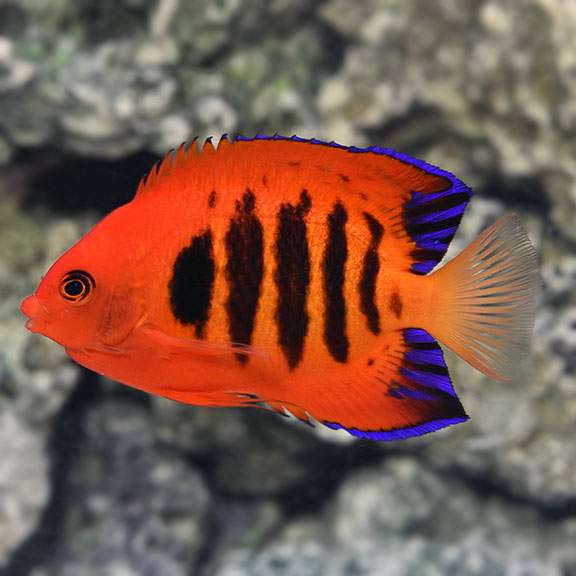
Size
Typically, Flame angelfish are under 4 inches long.
Physical characteristics and behavior
Their fins are rounded, and their bodies are compressed laterally. Red hues ranging from orange to vivid red are present on the head, body, and fins. When this happens, the center of the body usually has a stronger orange hue than the extremities. In addition to having zero to seven vertical black stripes running down the sides of the body, flaming angelfish have black dorsal fins. The anal fin and the second portion of the dorsal fin are filled with black, while the edges are blue. The pectoral fins and caudal fin are translucent orange.
Habitat
Their normal habitat consists of soft coral or rocky bottoms in shallow waters that range in temperature from 74 to 79 degrees Fahrenheit and have a pH of 8.0 to 8.4. Environmental statistics specific to water are as follows: Nitrate concentrations should be under 20 ppm, total alkalinity should be between 8 and 12 dKH, and phosphate concentrations should be below 0.05 ppm. The maximum acceptable water hardness is 15 dGH.
Care When Keeping as Pet

- Aquariums Care
Although the Flame Angel is less finicky than some of the other angelfish species, it still requires clean water. In order to maintain nitrate levels low, water changes of 30% per month or 15% every two weeks are ideal. If the aquarium contains corals, 20% every month, 10% every two weeks, or 5% every week work excellent. Naturally, keeping track of your water tests will allow you to determine when your tank requires a water change.
Water Changes: Every two weeks, or 30% of the water is changed.
- Setup of an aquarium
For a single person, the tank for a Flame Angel must hold at least 30 gallons. However, a smaller tank encourages aggressive and territorial behavior. They believe they must protect their area in a smaller tank, especially from invading algae eaters. A tank that is at least 55 gallons (208 l) in size and has a lot of algae growth is preferable. For a pair, 75 to 100 gallons (283 to 378 l) is required. Water should have the following specifications: sg 1.020–1.025, pH 8.1–8.4, and 72–82°F.
The pygmy angel prefers to forage for natural foods in places with a lot of rockwork, live rock, and rubble. To feel safe, they require a number of caverns and cracks in the rock formations to hide in. It is best to add this tiny angel to the tank as the last resident.
- Tank Size: A single specimen can be kept in a tank as little as 30 gallons, although for stability, a 55 gallons (208 l) tank with abundant algae growth is advised. For a pair, you’ll need a 75–100 gallon (283–378 l) tank, and you’ll need an additional 20 gallons for each additional dwarf angelfish.
- Nano tank-friendly: no live rock: Typical Plus Hiding Places: Live rock that has a lot of algae development is advised.
- Substrate Type: Any. They prefer to feed for algae and benthic organisms in areas of debris.
- Lighting requirements: Moderate to normal lighting is required; it is recommended that the lighting be powerful enough to prevent algae formation on the live rock.
- Temperature: 22.2 to 27.8 degrees Celsius or 72 to 80 degrees Fahrenheit.
- Omnivore diet: Provide a diet that includes Spirulina algae and sponge material.
Table





